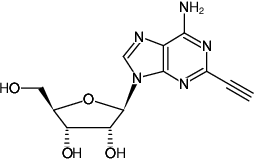| Cat. No. | Amount | Price (EUR) | Buy / Note |
|---|---|---|---|
| CLK-N005-1 | 1 mg | 99,00 | Add to Basket/Quote Add to Notepad |
| CLK-N005-5 | 5 mg | 383,10 | Add to Basket/Quote Add to Notepad |

For general laboratory use.
Shipping: shipped at ambient temperature
Storage Conditions: store at -20 °C
Short term exposure (up to 1 week cumulative) to ambient temperature possible.
Shelf Life: 12 months after date of delivery
Molecular Formula: C12H13N5O4
Molecular Weight: 291.26 g/mol
Exact Mass: 291.10 g/mol
Purity: ≥ 95 % (HPLC)
Form: solid
Color: white to off-white
Solubility: up to 4.0 mM in 1 x PBS
Applications:
mRNA poly(A) tail synthesis monitoring[1]
Description:
2-Ethynyl-labeled adenosine (2-EA) can be used to measure de novo mRNA poly(A) tail synthesis in proliferating cells. 2-EA is cell permeable and incorporates into nascent mRNA transcripts both transcriptionally by RNA polymerase I,II and III and posttranscriptionally by poly(A) polymerase instead of their natural analolg adenosine.
The resulting ethynyl-functionalized RNA can subsequently be detected via Cu(I)-catalyzed click chemistry that offers the choice to introduce a Biotin group (via Azides of Biotin) for subsequent purification tasks or a fluorescent group (via Azides of fluorescent dyes) for subsequent microscopic imaging[1].
Presolski et al.[2] and Hong et al.[3] provide a general protocol for Cu(I)-catalyzed click chemistry reactions that may be used as a starting point for the set up and optimization of individual assays.
Related products:
BIOZ Product Citations:
Selected References:
[1] Curanovic et al. (2013) Global profiling of stimulus-induced polyadenylation in cells using a poly (A) trap. Nat. Chem. Biol. 9 (11):671.
[2] Presolski et al. (2011) Copper-Catalyzed Azide-Alkyne Click Chemistry for Bioconjugation. Current Protocols in Chemical Biology 3:153.
[3] Hong et al. (2011) Analysis and Optimization of Copper-Catalyzed Azide-Alkyne Cycloaddition for Bioconjugation. Angew. Chem. Int. Ed. 48:9879.